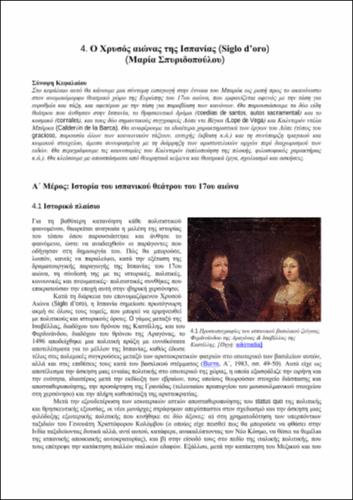| Title Details: | |
|
The Spanish Golden Age |
|
| Authors: |
Spyridopoulou, Maria |
| Reviewer: |
Lalagianni, Vasiliki |
| Subject: | HUMANITIES AND ARTS > ARTS AND LETTERS > PERFORMING ARTS > THEATRE AND PERFORMING ARTS > THEATRE HUMANITIES AND ARTS > ARTS AND LETTERS > PHILOLOGY > LITERARY FORMS AND GENRES > PROSE > SCRIPTS > PLAY SCRIPTS |
| Description: | |
| Abstract: |
We will begin with a brief introduction to the concept of Baroque as a tendency towards irregularity in the uneven theatrical landscape of 17th-century Europe. This period is characterized by a dual inclination: one towards harmony and order, and the other towards breaking the rules. We will present the two types of theater that flourished in Spain: religious drama (corrales, autos sacramentales) and secular theater (new comedies). We will focus on two significant playwrights, Lope de Vega and Calderón de la Barca. We will highlight the distinctive features of Lope's works (the gracioso type, the presence of all social classes, happy endings, etc.) and the coexistence of tragic and comic elements, which directly challenge the Aristotelian principles regarding the separation of genres. We will describe Calderón's innovations (simplification of plots, philosophical nature, etc.). The chapter will conclude with excerpts from theatrical texts, commentary and exercises, and an excerpt from "The New Art of Writing Plays".
|
| Linguistic Editors: |
Ntafos, Vaios |
| Type: |
Chapter |
| Creation Date: | 2015 |
| Item Details: | |
| License: |
http://creativecommons.org/licenses/by-nc-nd/3.0/gr |
| Handle | http://hdl.handle.net/11419/2931 |
| Bibliographic Reference: | Spyridopoulou, M. (2015). The Spanish Golden Age [Chapter]. In Tampaki, A., Spyridopoulou, M., & Altouva, A. 2015. History and Dramaturgy of European Theatre [Undergraduate textbook]. Kallipos, Open Academic Editions. https://hdl.handle.net/11419/2931 |
| Language: |
Greek |
| Is Part of: |
History and Dramaturgy of European Theatre |
| Publication Origin: |
Kallipos, Open Academic Editions |

